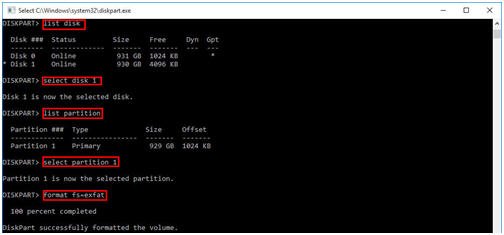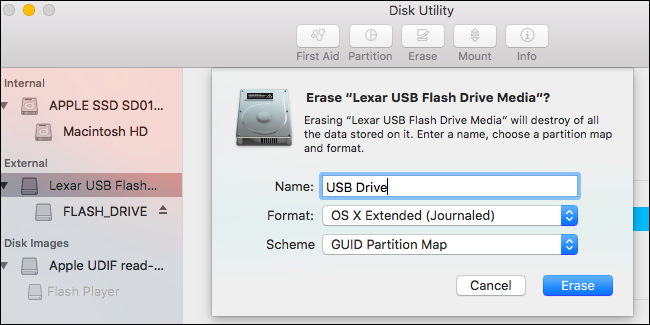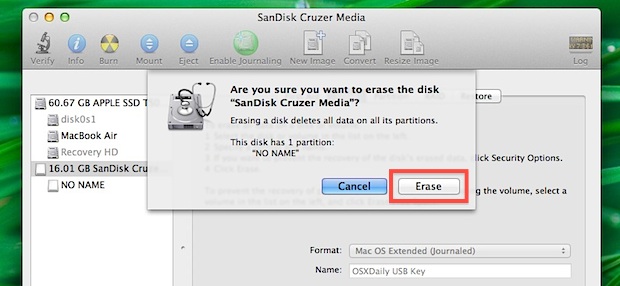Just like Windows, macOS also gives us a seamless option to format the hard drives for Mac (and PC). The operating system has an inbuilt tool, which is known as Disk Utility. Using it, you can erase a hard drive, create new partitions, and even repair your disk as well. The instructions below are for Windows 10, but other versions of Windows from Windows 7 and up can also format an external drive as exFAT for use with Mac as well. Connect the drive to your.
- Windows Usb Format Tool
- Cannot Format Usb Drive Windows 10
- Format Usb Drive For Both Mac And Windows
- Format Usb Flash For Mac And Windows
- Format Usb Drive For Mac And Windows
The way you format your USB drive determines the speed of your Rekordbox export and if your drive is recognized by DJ controllers and CDJs like the CDJ 2000.
So, choosing the right settings is crucial for convenience and compatibility.
In this article I’ll dive into the right settings and how to format your USB drive for Mac and Windows the right way.
Can CDJs read exFAT / NTFS?
No, CDJs can’t!
They only read FAT32 and HFS+.
Which format is best and step-by-step format instructions you can read in this article.
Best format for CDJ USB
The Pioneer CDJ machines support three types of file system formats:
• Microsoft FAT
• Microsoft FAT32
• Apple HFS+
Below you can find my recommended file system, pros and cons of each file system.
Later in this article I will give you step-by-step instructions to format your USB drive on Mac and Windows the right way.
You probably noticed that the supported standards are replaced by newer more reliable ones with less (storage) limitations.
FAT32 is replaced by NTFS in 1993, HFS+ is replaced by APFS in 2017.
I can only guess to why Pioneer choose to support these older standards instead of the newer standards, probably licensing issues.
For now, we have to work with the limitations.
Formatting USB drive on Mac for Rekordbox
- Make sure Rekordbox is closed!
- Insert the USB drive
- Start “Disk Utility” by pressing Command+Spacebar and type “disk”, select the first item in the list or press Enter.
- Select the USB drive in the drive list on the left. Make sure you select the drive, not the partition below (otherwise you will miss vital setting later).
- Click on “Erase” (translation: format) at the top of the screen.
- The Erasewindow will appear.
- Choose a name for you dive in Name
- Format: select “OS X Extended Journaled” for HFS+ or “MS DOS FAT”
If you choose FAT, you only can use 32GB of your drive if your drive is larger than 32 GB. - Scheme: select “Master Boot Record”. IMPORTANT!! (you will miss this option if you selected the partition instead of the drive in the previous step).
- Now click on the “Erase” button below the formatting options.
- Wait a few seconds, your drive is now being formatted.
- Click “Done” and close the Disk Utility.
- You drive is now ready to use in Rekordbox.
Formatting USB drive on Windows for Rekordbox
We can’t format drives larger than 32GB with the Windows built-in tools.
So we need third party software called “Fat32 Format” (download: http://www.ridgecrop.demon.co.uk/index.htm?guiformat.htm )
We can also format smaller drives with Fat32 Format, so this is the method I’m going to use for this tutorial.
- Before we start, make sure Rekordbox is closed
- Insert your USB drive
- Make sure all your Explorer windows are closed, otherwise you can’t format the drive
- Start Fat32 Format
- Select the drive letterof your USB drive. NEVER choose C:
- Select allocation size: 4096
- choose a name for your USB drive in “Volume label”
- Click Start
- Select OK
- Your drive is being formatted, this takes a few seconds
- Your drive is now finished formatting
- select Close
If you want to know how to export tracks from Rekordbox to USB read this article.
If you are serious about Djing and want take it to the next level, check out my CDJ 2000 course or my Rekordbox course.

Summary: This article tells how to format a USB flash drive on Windows 10/8/7 and Mac when you want to reformat a new or second-hand removable storage device to make sure it doesn’t contain any malicious files or fix the logical errors.
What is Formatting?
Formatting is the fastest way to prepare the USB flash drive for the initial use. It wipes all the data stored on your flash drive and allows full use of the storage capacity. Meanwhile, it also creates a filing system that can help organizes your data on Windows or Mac.
Which File System Should I Choose for a USB Flash Drive?
We can’t talk about formatting without talking about file system as it differs when we are using the different computers; the common file systems are FAT32, exFAT, and NTFS for Windows, APFS, HFS+, and exFAT for macOS, here we will only talk about the most common file systems when formatting a USB flash drive:
- FAT32: It’s compatible with all major operating systems and uses less memory usage. But it cannot handle single files larger than 4GB and has a limited partition size (up to 32GB).
- NTFS: It can create partitions larger than 32GB and read/write files larger than 4GB. Besides, it supports on-the-fly file encryption. The disadvantage is that the Mac computer can only read the data from the NTFS drive.
- exFAT: It provides an unlimited file and partition size. It serves no matter the Windows or Mac users who want to work with files larger than 4GB.

Windows Usb Format Tool
We strongly recommend that you use exFAT, which is considered the best choice for both Windows and Mac computers, whereas the exFAT file system works better than FAT32 and can handle the file size up to 16GB.
How to Format a USB Drive on Windows 7/8/10?
After deciding which file system you are going to apply, let’s explore the formatting methods. Generally, On Windows 10, 8, 7, there are some common ways you can format a USB flash drive.
Method 1: Format a USB Flash Drive Using File Explorer
This is the easiest way with which many users are familiar. Refer to the following steps to learn how.
Step 1: Connect your USB flash drive and open press Win key + E to open File Explorer.
Step 2: Right-click on the drive and choose the Format option.
Step 3: Expand the File system drop-down menu and select the exFAToption.
Step 4: Click on the Start button.
Note: Uncheck the Quick Format means full format; it goes with a thorough scanning and wiping your data on the USB flash drive, you will have no chance to get back your data after using this option.
Method 2: Format a USB Flash Drive Using Diskpart
Using diskpart to format a USB flash drive is another useful method, and even it works for the computer user who has no exFAT options in File Explorer or Disk Management. However, the user should select the correct volume before carrying out a quick or full format on your USB flash drive:
Cannot Format Usb Drive Windows 10
Step 1: Enter Command Prompt in the search bar and then right-click it, choose Run as administrator.
Step 2: Enter below-written commands in the same order and same diskpart window:
- diskpart
- list volume
- select volume NUMBER (Replace NUMBER to the exact number of your USB flash drive)
- format fs=exFAT quick (Don’t enter quick if you want a full format)
Note: Replace exFAT if you choose another file system, for example, enter the command format fs=fat32 to format the USB flash drive into FAT32 format.
Method 3: Format a USB Drive Using Disk Management
This is a method similar to the one performed by using File Explorer, and here are the steps you can follow:
Step 1: Press Win + Q, type in Disk Management and open it.
Step 2: Right-click on the desired USB flash drive and select Format.

Step 3: Select exFAT from the File System drop-down menu.
Step 4: Click on the OK button.
Method 4: Format a USB Flash Drive Using PowerShell (Windows 10 Only)
PowerShell is a task and configuration management platform which was first appeared in 2006; it’s powerful than Command Prompt that can be used to automate many different system administration tasks, and of course, for formatting a USB flash drive:
Step 1: Right-click on the Start menu at the lower-left corner and choose Windows PowerShell(Admin).
Step 2: Enter the following command to view the USB flash drive you want to format:
- Get-Volume
- Format-Volume -DriveLetter F -FileSystem exFAT (Replace F to the exact drive letter of your USB flash drive)
Note: In this method, you should note that after entering the format command, it goes to format the USB flash drive to exFAT directly, and if you want a FAT32 drive, just replace exFAT to FAT32, that’s all.
How to Perform a USB Drive Format on Mac?
Reformatting a USB flash drive in exFAT on Mac is easy than you imagine; we should thank the Disk Utility that can make the reformatting easy to complete; Likewise, follow with the same steps if you would like to reformat an SD card, internal or external hard drive:
Step 1: Connect the USB stick to the PC with one of the USB ports and then press Command + Space to search Disk Utility.
Step 2: After selecting the drive on the left part of the Disk Utility window, click on the Erase button lying at the top of the window.
Step 3: Now, select exFAT from the drop-down menu of the Format.
Step 4: Click the Erase and wait for the reformatting process to complete.
Note: Please back up your data before the formatting of your USB flash drive as Erase will wipe all of the stored data!
What if you were not intended to format the USB flash drive, and there are lots of the vital photos, videos, documents, or any other files stored on the drive that have been lost due to the reformatting. What should we do to retrieve lost data? Don’t worry, a quick format won’t cause all of the data to lose, the file contents still exist on the USB flash drive, and you will have a big chance to get back your data as soon as you launch the third-party data recovery program – Bitwar Data Recovery to perform a full scan.
Recover Files From a Formatted Drive Using Bitwar Data Recovery
No matter how carefully or gradually backing up the USB flash drive, the data loss is still inevitable, such as the USB flash drive turns to a RAW drive suddenly, or you might unplug the drive without safely removing from the computer; moreover, the backup files are out-to-dated when the accident happens.

We have experienced many of the users encountered the same frustrating issue that causes the works to stop, and most of them finally chose to start the work again as they didn’t know how to restore the data. Right now, you’ll be all set if using Bitwar Data Recovery with the steps below:
Step 1: Go toBitwarsoft Download Center to download and install Bitwar Data Recovery.
Step 2: After completing the installation, open the Bitwar data recovery software and then select the formatted USB flash drive.
Step 3: Choose a recovery mode. We strongly recommend you choose the Quick Scan for the first time since this mode scans the whole drive in just a few minutes. However, if this mode can’t work to find your data, try with the Deep Scan mode next time.
Step 4: Choose the File types and then press the Scan button.
Step 5: Double-click on wanted files to preview them. After that, click on Recover to save the files to a safe place.
Note: Please be careful not to save the recovered files to the formatted USB flash drive. The reason is to prevent the data from being overwritten again.
Conclusion
Like many other storage devices, The USB flash drive can be easily failed without any concerns. There are many possible causes behind the happening of this accident, such as the unstable flash chip, disconnect the USB flash drive before safely removing from the computer, virus attack, or Trojan infection. Some of the failures are just logic errors that can be fixed easily by reformatting the drive. Some failures prove that your USB flash drive was physically damaged, and that means you may have to consider buying a new one.
Format Usb Drive For Both Mac And Windows
If you purchase a brand-new USB flash drive and want an initial usage or the USB flash drive has encountered any logic errors as told, this article serves you very well, as it tells how to format a USB flash drive with different methods on Windows or Mac. What if there were vital data stored on the USB flash drive, it is suggested to retrieve the data using Bitwar Data Recovery before starting the formatting.
Follow with the steps mentioned above and hope that you can finally reformat the USB flash drive or get back the wanted data.
Format Usb Flash For Mac And Windows
How useful was this post?
Click on a star to rate it!
Average rating 4.9 / 5. Vote count: 11
No votes so far! Be the first to rate this post.
Previous Article
How To Solve This Build Of Windows Will Expire Soon? Summary: This article tells how to format a USB flash drive on Windows 10/8/7 and Mac when you want to...Next Article
Best Free Online PDF Converter On Windows! Summary: This article tells how to format a USB flash drive on Windows 10/8/7 and Mac when you want to...About Bitwar Data Recovery
3 Steps to get back 500+ kinds of deleted, formatted or lost documents, photos, videos, audios, archive files from various data loss scenarios.
Format Usb Drive For Mac And Windows
Learn More